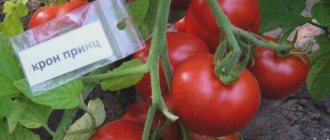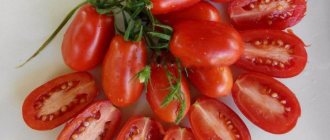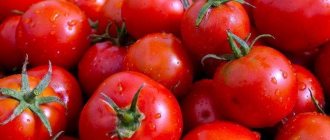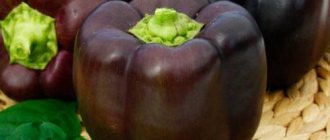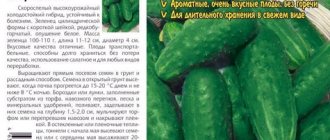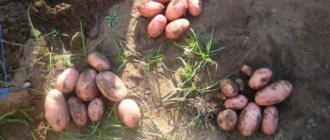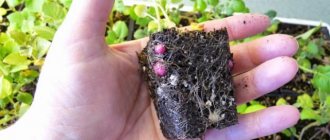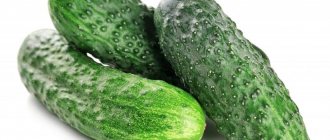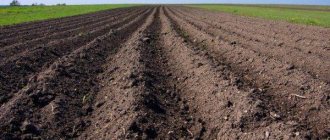Tomato Voyage F1 regularly receives a lot of positive feedback from gardeners. I like it for its delicious tomatoes, productivity, and unpretentiousness. The hybrid is included in the register for planting and growing under films.
| Height | Landing location | Ripening time | Fruit color | Fruit size | Origin | Fruit shape |
| Tall | Greenhouse | Early ripening | Pink | Average | Hybrid | With spout |
Description and characteristics of the variety
Voyage is an indeterminate tall hybrid, shoots grow up to 1.8 m in length. Powerful stems require gartering and shaping. The tops are pinched and 8-9 fruiting clusters are left on the bush.
Tomatoes have a raspberry-pink color. The shape is round, and there are pointed noses on the tops of the fruits. The ribbing is weakly expressed at the stalk.
Tomatoes have rich, fleshy flesh that is juicy but not watery. The taste is sweet and slightly sour. Tomatoes are good in fresh salads, canned in pieces and dried. Juices and pastes are prepared from them and used for hot dishes.
Ripening time is early - 95 days from germination.
Features of growing Voyage tomatoes, planting and care
sowing the seeds of this tomato for seedlings 60-65 days before the intended planting in the ground. Seedlings dive at the stage of two true leaves. When planting seedlings in a permanent place per 1 sq. It is recommended to place up to 3 plants per meter of land; when forming into 1 stem - up to 4.
Further care for tomatoes consists of timely watering, fertilizing with complex mineral fertilizer, pinching and preventive measures to protect against diseases and pests.
When growing tomatoes, we recommend installing a drip irrigation system - this saves you time and effort, and also increases plant productivity and reduces the risk of late blight.
If you grew Voyage tomatoes, please write whether you liked them or not. What was the yield and taste of the fruits like under your climatic conditions? How do you rate the disease resistance of this hybrid? If possible, attach a photo of your tomatoes to your comment. Thank you!
Your feedback on the Voyage tomato and additions to the description will help many gardeners evaluate the hybrid variety more objectively and decide whether it is worth planting or not.
Tomato cultivation
Planting in the garden begins at the end of May. By this time, the threat of frost will have disappeared, and the soil will have warmed up thoroughly.
Landing
The best place for tomatoes is considered to be the ground in which carrots, beets, cabbage, onions, beans or spinach previously grew. In autumn, the soil is dug up and fertilized with bird droppings, ash, compost or humus at a rate of 5 kg per 1 m². The best mineral fertilizers are potassium salt (20–25 g per 1 m²) and superphosphate (40–50 g per 1 m²).
Holes for seedlings are dug at a depth of 15 cm and spilled with a hot solution of potassium permanganate. The soil in the containers is moistened abundantly so that the seedlings can be removed without any problems. The lower leaves are torn off and, together with the earthen lump, transferred into the hole.
6-7 seedlings are planted per 1 m² at a distance of 70 cm and watered with warm, settled water.
The soil is mulched with straw or sawdust in a 10 cm layer. The plantings are covered with film and left to take root in a new place for 8–10 days. A hole is made in the film to prevent the risk of late blight infection in the created greenhouse conditions.
About other varieties of tomatoes:
Tomato care is standard and includes weeding, weed removal, watering, loosening, and fertilizing.
10 days after planting, the plants are watered at the root with warm water. Do this once a week, in the evening. With the onset of heat, the soil is moistened every 2-3 times every 7 days.
Tomatoes are fertilized once every 10 days according to the following scheme:
- 2 weeks after planting - 1 part mullein per 10 liters of water.
- Subsequent fertilizing is potassium-phosphorus - 60 g of nitrophoska per 10 liters of water.
Before flowering, the consumption per bush is 1 liter, after - 2–5 liters.
Forming bushes into 2 stems significantly increases productivity. The stepsons are carefully broken out or cut off with a sharp knife.
Important! 10 days after planting, the bushes are tied to low stakes to prevent the stems from breaking under the weight of the tomatoes.
Prevention of diseases and pests
Shady Lady tomatoes are resistant to nightshade diseases: verticillium, fusarium, cladosporiosis, tobacco mosaic virus (TMV).
To prevent late blight (brown spots on leaves, stems and fruits), the bushes are regularly irrigated:
- fungicides: “Previkur”, “Fitosporin”, “Quadris”, “Topaz”, “Chorus”, “HOM”, as well as Bordeaux mixture, copper sulfate, according to the instructions;
- infusion of garlic with potassium permanganate (100 g of chopped garlic cloves, pour 250 ml of water, leave for 24 hours, bring the volume to 10 l and add 1 g of potassium permanganate);
- yeast solution (dilute 80 g of pressed yeast in 10 liters of water);
- a solution of milk with iodine (add 1 liter of low-fat milk and 20 drops of iodine to 10 liters of water);
- whey diluted with water in a 1:1 ratio.
Bushes are treated with folk remedies before flowering begins, then every 10–14 days. The use of chemicals is stopped 2 weeks before the start of harvest.
Preventive measures will help prevent infection:
- mulching beds with peat, sawdust, pine needles;
- spring disinfection of soil with copper sulfate (100 g of dry matter per 10 liters of water);
- compliance with the irrigation regime in order to prevent excess moisture in the soil;
- timely application of potassium-phosphorus fertilizers.
The following will help you cope with aphids, whiteflies, and spider mites:
- modern insecticides: “Commander”, “Iskra”, “Intavir”;
- biological products: “Fitoverm”, “Biotlin”, “Strela”.
Among folk remedies, the most effective are:
- Garlic infusion. To prepare it, add 400 g of finely chopped garlic arrows to 1 liter of warm water and leave for 4-5 days. The bushes are treated 3 times during the entire growing season, every 3 days.
- Ash. Add 50 g of ash to 10 liters of water, stir and filter through cheesecloth. Then pour in 50 ml of liquid soap. Apply the solution to spray the bushes on an ongoing basis every 14 days.
- Infusion of tobacco. Add 200 g of shag to 5 liters of warm water and leave for 48 hours. The plants are treated with the liquid 3-4 times with an interval of 3 days.
Marigolds, calendula, leaf mustard, and fragrant dill are sown between the beds to attract ladybugs that prey on aphids.
Reviews
Tatiana:
“The Voyage variety is one of the best. Only correct agricultural technology is aimed at obtaining a good and rich harvest. In fact, obtaining a high-quality harvest is possible, but only with proper and constant care for Voyage tomatoes.”
Marina:
“I really love growing Voyage tomatoes. Proper agricultural technology, which is actually easy, allows you to get a rich and nutritious harvest with impeccable taste characteristics. Even I managed to grow Voyage tomatoes the first time.”
Description of tomato Voyage f1, reviews of the variety
This variety is early ripening and indeterminate, i.e. the bush has a height of 2 meters. Front leaves, small in size. Since the variety is tall, it needs staking and bush formation. When ripe, the fruits have a round shape, a smooth and dense structure, and a pink color. The weight of one fruit is 120-150 g. You can get 14-18 kg per square meter.
The Voyage f1 variety is a hybrid, and hybrids are characterized by positive qualities, namely:
- High knotting
- Resistance to many diseases
- Gradual maturation
- Tolerance to temperature changes
- Long seed germination
Voyage f1 is resistant to late blight, fusarium wilt, and alternaria. In addition, the fruits do not lose their transportable qualities during long-term transportation. According to reviews of many gardeners, this variety is very popular.
When to plant a tomato and how to prepare for planting
The timing of planting seeds will depend on where they will be planted - in open ground or in a greenhouse. Voyage f1 is a hybrid and belongs to an early ripening variety, so the optimal time for planting seeds for seedlings is the end of February - beginning of March.
Seed material should be prepared in advance. First you need to disinfect the purchased seeds. They must be immersed in a weak solution of potassium permanganate for 10-15 minutes. After this, it is recommended to soak in Epin solution and leave for 18 hours. During this time, the seeds will swell and can be sown.
Soil for sowing can be purchased at a special store. Level the ground, slightly moisten it and spread the seeds over the surface, and then press it to a depth of 0.5-0.7 cm. It is important to leave 2 cm between seeds, and 3-4 cm between rows. Cover the containers with film and place in a warm room , where the temperature is about 22-25 degrees.
Once a day, you should open the mini-greenhouse with seedlings and ventilate. With proper planting, seedlings can be expected within 4-9 days. After this, remove the film and place the container in a sunny place. Seedlings should be watered as the soil dries. With the appearance of 2-3 leaves, pick them into separate cups.
Planting tomato seedlings Voyage f1 will allow you to get a richer harvest than when growing vegetables in open ground. The optimal age for planting seedlings in a greenhouse is 50 days. The plant has a well-developed system and will take root in the new soil.
In the greenhouse, potassium-phosphorus fertilizer should be added to each hole. The seedlings are carefully planted in the hole and the soil is compacted. The optimal distance between the holes is 50-60 cm. When planting Voyage f1 tomatoes, you should adhere to the recommendations listed above.
General information
The Voyage tomato variety is early ripening and begins to bear fruit in 85–90 days. The height of the bush reaches two meters. The fruits have a pink tint and are pleasant to the taste.
The characteristics of the vegetable crop are perfectly presented in the table:
| Name | Characteristic |
| Fruit ripening period | Early ripening (85 – 90 days) |
| Variety | Hybrid |
| Use of fruits | Salad, tomato products |
| Taste of fruits | Nice |
| Planting | 70x60 cm |
| Growing | Open and closed ground |
| Features of cultivation | Weeding, watering, loosening, fertilizing |
| Fruit color | Pink |
| Fruit weight | 120 – 150 grams |
| Productivity | 14 – 18 kg/m2 |
The description of the variety includes the following criteria among the advantages of a vegetable crop:
- high level of tying;
- high immunity;
- high level of seed germination;
- high yield.
Reviews from experienced gardeners indicate that the variety is resistant to various diseases.
Tomato care
Voyage tomatoes, like any vegetable crop, require certain care:
- Hilling is carried out when tubercles appear on the plant stem.
- Feeding is necessary in moderation. At the beginning, nitrophoska is used (1 liter per 1 plant). In the future, mineral and organic fertilizers are used.
- Watering is an important part of the growing process. The water temperature should be about 22 – 24 °C. To water 1 m2 you will need about 5 liters of water. Please note that tomatoes need to be hydrated as needed.
- Gartering bushes is one of the essential aspects of caring for plants. Since tomatoes have a tall stem, they need additional support. As a rule, this is done in the form of gartering bushes using special pegs.
